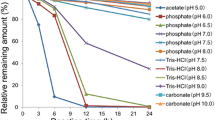Abstract
Transgalactosylation of chitobiose and chitotriose employing β-galactosidase from bovine testes yielded mixtures with β1-3 linked galactose (type I) and β1-4 linked galactose (type II) in a final ratio of 1:1 for the tri- and 1:1.4 for the tetrasaccharide. After 24 h incubations of the two purified oligosaccharide mixtures with large amounts (20-fold increase compared with standard conditions) of human α1, 3/4-fucosyltransferase III (FucT III), the type I tri-/tetrasaccharides were completely converted to the Lewisa structure, whereas approximately 10% fucosylation of the type II isomers to the Lewisx oligosaccharides was observed in long-term incubations.
Employing large amounts of human α1, 3-fucosyltransferase VI (FucT VI), the type I trisaccharide substrate was exclusively fucosylated at the proximal O-4 substituted N-acetylglucosamine (GlcNAc) (20%) whereas almost all of the type II isomers was converted to the corresponding Lewisx product. 45% of the type I tetrasaccharide was fucosylated at the second GlcNAc solely by FucT VI. The type II isomer was almost completely α1-3 fucosylated to yield the Lewisx derivative with traces of a structure that contained an additional fucose at the reducing GlcNAc. The results obtained in the present study employing high amounts of enzyme confirmed our previous results that FucT III acts preponderantly as a α1-4 fucosyltransferase onto GlcNAc in vitro. Human FucT VI attaches fucose exclusively in an α1-3 linkage to 4-substituted GlcNAc in vitro and does not modify any 3-substituted GlcNAc to yield Lewisa oligosaccharides. With 8-methoxycarbonyloctyl glycoside acceptors used under standard conditions, FucT III acts exclusively on the type I and FucT VI only on the type II derivative. With lacto-N-tetraose, lacto-N-fucopentraose I, or LS-tetrasaccharide as substrates, FucT III modified the 3-substituted GlcNAc and the reducing glucose; FucT VI recognized only lacto-N-neotetraose as a substrate.
Similar content being viewed by others
References
Berg EL, Magnani J, Warnock RA, Robinson MK, Butcher EC (1992) Biochem Biohpys Res Commun 184: 1048–55.
Foxall C, Watson SR, Dowbenko D, Fennie C, Lasky LA, Kiso M, Hasegawa A, Asa D, Brandley BK (1992) J Cell Biol 117: 895–902.
Takada A, Ohmori K, Takahashi N, Tsuyuoka K, Yago A, Zenita K, Hasegawa A, Kannagi R (1991) Biochem Biohpys Res Commun 179: 713–9.
Varki _ A (1994) Proc Nat Acad Sci U S A 91: 7390–7.
Johnson PH, Watkins WM (1992) Glycoconjugate J 9: 241–9.
Johnson PH, Donald ASR, Feeney J, Watkins WM (1992) Glycoconjugate J 9: 251–64.
de Vries T, Srnka CA, Palcic MM Swi SJ, van den Eijnden DH, Macher BA (1995) J Biol Chem 270: 8712–22.
Costa J, Grabenhorst E, Nimtz M, Conradt HS (1997) J Biol Chem 272: 11613–21.
de Vries T, van den Eijnden DH (1994) Biochemistry 33: 9937–44.
Grabenhorst E, Costa J, Conradt HS (1996) In Animal Cell Technology: from Vaccines to Genetic Medicine (Carrondo MJT, Griffiths B, Moreira JLP, eds), pp 481–7. Kluwer Academic Press.
Nimtz M, Noll G, Pâques E-P, Conrad HS (1990) FEBS Lett 271: 14–8.
Nimtz M, Martin W, Wray V, Klöppel K-D, Augustin J, Conradt HS (1993) Eur J Biochem 213: 39–56.
Grabenhorst E, Hoffmann A, Nimtz M, Zettlmeissl G, Conradt HS (1995) Eur J Biochem 232: 718–25.
Gamber U, Thiem J (1997) Carbohydr Res 299: 85–9.
Hakomor S. (1964) J Biochem (Tokyo) 55: 205–7.
Egge H, Katalinic J (1987) Mass Spectrometry Rev 1987: 331–93.
Kitagawa H, Nakada H, Kurosaka A, Hiraiwa N, Numata Y, Fukui S, Funakoshi I, Kawasaki T, Yamashina I, Shimada I, Inagaki F (1989) Biochemistry 28: 8891–7.
18 Haeuw-Fievre S, Wieruszeski JM, Plancke Y, Michalski JC, Montreuil J, Strecker G (1993) Eur J Biochem 215: 361–71.
Koszdin KL, Bowen BR (1992) Biochem Biophys Res Commun 187: 152–7.
de Vries T, Palcic MP, Schoenmakers PS, Van den Eijnden DH, Joziasse DH (1997) Glycobiology 7: 921–7.21.
Kukowska-Latallo JF, Larsen RD, Nair RP, Lowe JB (1990) Genes Dev 4: 1288–03.
Lowe JB, Stoolman LM, Nair RP, Larsen RD, Berhend TL, Marks RM (1990) Cell 63: 475–84.
Weston BW, Smith PL, Kelly RJ, Lowe JB (1992) J Biol Chem 267: 24575–84.
Melo NS, Nimtz M, Conradt HS, Fevereiro PS, Costa J (1997) FEBS Letters 415: 186–91.
Morr M, Mùller E (1997) European patent Nr. 0721 372 B1.
Author information
Authors and Affiliations
Rights and permissions
About this article
Cite this article
Nimtz, M., Grabenhorst, E., Gambert, U. et al. In vitro α1-3 or α1-4 fucosylation of type I and II oligosaccharides with secreted forms of recombinant human fucosyltransferases III and VI. Glycoconj J 15, 873–883 (1998). https://doi.org/10.1023/A:1006907031940
Issue Date:
DOI: https://doi.org/10.1023/A:1006907031940




